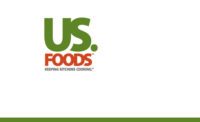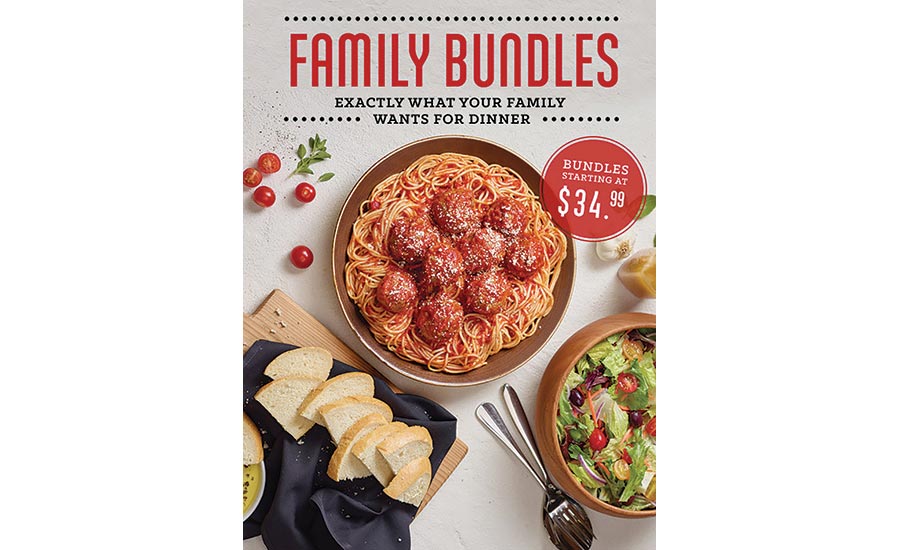Off-Premise Meal Decisions
Changing consumer needs and wants—paired with advancements in technology—have created a climate in which off-premise offerings are a necessity to growing foodservice business.

Changing consumer needs and wants—paired with advancements in technology—have created a climate in which off-premise offerings are a necessity to growing foodservice business.
SOURCE: PIZZA HUT INC / WWW.PIZZAHUT.COM

Chili’s is rolling out a curbside pickup option on its mobile app.
SOURCE: CHILI’S, BRINKER INTERNATIONAL / WWW.CHILIS.COM

Domino’s introduces Zero Click ordering app.
SOURCE: DOMINO’S PIZZA INC / WWW.DOMINOS.COM

Carrabbas offers Family Bundles meal kit delivery.
SOURCE: CARRABBAS ITALIAN GRILL, BLOOMIN’ BRANDS / WWW.CARRABBAS.COM




The advancements made in technology over the past few years have allowed restaurants to offer voice-recognition ordering, social media, and in-app ordering and delivery robots. This May, McDonald’s unveiled plans to make its mobile app the central hub for off-premise occasions that range from delivery to curbside pickup.
With all these technological developments, the story of off-premise is sort of similar to the chicken-or-the-egg question: Do consumers’ behaviors and demands drive development, or does development drive consumers’ usage? It’s probably a bit of both and, either way, consumer responses are loud and clear. They want more off-premise foodservice options.
Off-premise Overview
Consumers purchase takeout from restaurants about five times per month, on average, shows Technomic’s “Takeout & Off-Premise Dining Consumer Trend Report.” Who are these consumers? They’re young. They’re Hispanic. They’re men. They’re college students. Their numbers are growing.
Among today’s consumers, shows the report, men and those aged from 18-34 drive to-go orders, as they are more reliant on foodservice than their counterparts, in general. In addition, half of all Hispanic diners say takeout service is extremely important when choosing a limited-service restaurant to visit, compared to two-fifths of respondents who said the same two years ago, according to Technomic’s “Hispanic Foodservice Consumer Trend Report.”
Technomic research also shows that about half of all consumers between the ages of 18-34 (49%) say they’re ordering food to-go more often today than they were three years ago. Consumers tend to view takeout meals as alternatives to food prepared at home. In addition, takeout appeals to consumers who don’t feel like dining in at a restaurant, signaling that takeout can drive additional restaurant traffic, rather than cannibalizing dine-in revenue.
Delivery Deep Dive
Arguably the biggest topic in off-premise business today is delivery service. Although takeout orders currently outnumber delivery orders by three-to-one, due to availability and lower costs, this dynamic is shifting, shows data from Technomic’s “Takeout & Off-Premise Dining Consumer Trend Report.” A fifth of consumers overall (19%) say they increasingly are replacing carryout orders with delivery orders. And more than a third of consumers (35%) say it’s more convenient to order delivery than carryout.
Younger consumers particularly are fueling a shift away from carryout and toward delivery. More than a third of consumers between the ages of 18-34 (35%) say they increasingly are replacing carryout orders with delivery orders, and nearly half of these young consumers (47%) say it’s more convenient to order delivery than carryout. In addition, a quarter of younger consumers (26%) say they are using third-party delivery services, such as UberEATS, more often now than a year ago.
Delivery is positioned to grow further at both limited- and full-service restaurants. Nearly half of consumers aged 18-34 (46%) say they would use delivery for takeout orders at limited- service restaurants, and half of that age bracket says the same for full-service restaurants.
Similarly, 44% of today’s college students want more on-campus foodservice locations to offer delivery, shows Technomic’s “College & University Consumer Trend Report.” Further, nearly three in 10 college students (27%) say delivery service is important to their foodservice purchases on- and off-campus, up from 22% who said the same in 2015.
Conveniently located foodservice establishments are less of a priority, when students can have food dropped at their doorstep. Just over half of college students (53%) say a convenient location is important to food and beverage purchases, down from 59% in 2015.
Full-service Struggles
Delivery is a key way for the struggling full-service restaurant segment to grow business. Although takeout is still two-to-three times more common at full-service restaurants than delivery service, consumers say they are using delivery service more often now at both traditional and upscale casual-dining restaurants than they were in 2014. Specifically, 7% of orders from traditional casual-dining chains now are for delivery (up from 4% in 2014), and 8% of orders from upscale casual-dining brands are for delivery, up from 4% in 2014.
Several leading full-service chains are starting to test and roll out delivery service, including Buffalo Wild Wings, BJ’s Restaurant & Brewhouse, Home Run Inn, Outback Steakhouse, Carrabba’s Italian Grill, The Cheesecake Factory, Applebee’s and Chili’s Grill & Bar. Olive Garden recently launched delivery service for catering packages $125 and up, as well. Buffalo Wild Wings is even testing smaller prototypes that focus on delivery and takeout, expected to open in the third quarter of this year.
Tech-focused Delivery
Technology-enabled ordering and payment methods are necessary to driving off-premise orders at restaurants. Although the top preferred ordering method is still call-ahead—the preference margins between call-ahead and computer, as well as call-ahead and mobile ordering, are both quickly closing. Two-fifths of consumers (40%) say they would be likely to use mobile ordering for to-go orders at limited- and full-service restaurants. A similar proportion of consumers say they would be likely to prepay for these orders, shows the “Off-premise Report.”
Nearly two-fifths of consumers (38%) say they would like the ability to track their order until it is delivered at restaurants, and nearly as many express interest in a system that saves their favorite menu items to make reordering easier. Domino’s, for example, offers pizza tracking capability on mobile and desktop devices (and now on smart devices in the home), as well as Zero Click ordering, an app that saves favorite orders and then submits them to the store 10 seconds after the app is opened by the customer.
The same younger consumers who are driving demand for delivery also are encouraging the development of the tech-based amenities often provided with these services. Three-fifths of consumers between the ages of 18-34 (57%) say they would be likely to use mobile ordering for limited-service restaurant takeout, compared to 40% of their older counterparts, shows the “Off-premise Report.” In response, operators are developing easier ordering technology, such as via chatbot, text message and social media.
TGI Fridays, Pizza Hut, Wingstop and Burger King are testing or adding delivery service via social media, while Mazzio’s Italian Eatery introduced a service allowing customers to place orders using text message. Meanwhile, Chipotle Mexican Grill is improving its digital ordering capability through an updated website, so customers can order via mobile without downloading an app. Chipotle thereby hopes to tackle the issue of limited app space on mobile devices.
Up Next?
Delivery-only concepts will emerge to steal some share of this off-premise boom. Operators will decrease overhead with smaller commissaries and fewer staff at these types of delivery-only restaurants. They will develop a menu made for delivery, with menu items that hold up well for at least 25 minutes. Some of these storefront-less concepts may experiment with futuristic delivery methods, like self-driving robots and drones—about a third of young consumers note interest in both.
Curbside Convenience
Curbside pickup is making a comeback at restaurants as of late, due to the uptick in takeout business. Red Robin Gourmet Burgers and Brews has added curbside pickup at 10% of its stores and aims to hit the 25% mark by midyear. It also will feature a team member specializing in to-go orders at all corporate stores by midyear.
Chili’s recent mobile app update features a curbside pickup option for prepaid orders, as well. McDonald’s is currently planning to launch a similar app function. Clearly, it’s a big year for curbside options, and many chains will likely jump on the bandwagon in the months to come.
Catering
Most parents with young children are millennials, and 31% of millennials say they would use restaurant catering for an everyday dinner with family. And almost half of millennials (44%) would use restaurant catering for a special occasion dinner with a family. Full-service chains are taking note, launching and marketing a slew of catered family meals for dinner. These meals typically feature shareable family-style entrees or family-style bundles.
For example, Carrabba’s Italian Grill introduced Family Bundles to feed four people on the carryout menu last year, and Olive Garden recently added a limited-time takeout Family Style Lasagna Bundle for eight people. Italian chains are driving the charge for catered family dinners, but varied-menu chains will soon follow suit. Varied-menu chains, more than other restaurant menu categories, most need to differentiate—and this is one way to do so.
Takeout-ready Quality
Consumers expect the quality and taste of takeout fare to match that of dine-in occasions. Three-fifths of consumers (60%) say the most important factor they consider for takeout food purchases is that the food tastes just as good as it does when dining in, shows the “Off-premise Report.” This is even more important than order accuracy. So how can proactive operators respond by developing takeout-ready menu products?
Emerging New York-based Dinosaur Bar-B-Que chain recently developed a more portable barbecue bowl for on-the-go lunch occasions, which is easier and quicker to consume than the chain’s traditional, meat-heavy barbecue platters. The chain adds 3oz of meat to salad and other ingredients in the black plastic clamshell bowl for takeout.
Overall, Technomic’s “Takeout & Off-premise Dining Consumer Trend Report” shows that consumers prefer sandwiches and burgers for lunch takeout, and pizza and Chinese food for dinner takeout. Other favorite food items for takeout include salads, fried chicken, Mexican and Italian fare, barbecue and steak. Preferred items tend to be lighter and more portable for lunch and larger, center-of-the-plate entrees for dinner.
Although some chains still are holding back from delivery, due to concerns like dine-in cannibalization or compromised food integrity, these operators soon will find themselves cornered out of an increasingly necessary foodservice market, if they don’t change with the times. Because the easier takeout becomes—with better packaging, ordering and payment options, curbside pickup and delivery—the more consumers are subscribing to it. Starting small with a limited takeout menu and test-runs in young, urban markets should be a few of the first steps for national chains looking to take the leap and tackle takeout.
Originally appeared in the August, 2017 issue of Prepared Foods as Off-premise Business: A Critical Grow Path.
Looking for a reprint of this article?
From high-res PDFs to custom plaques, order your copy today!









